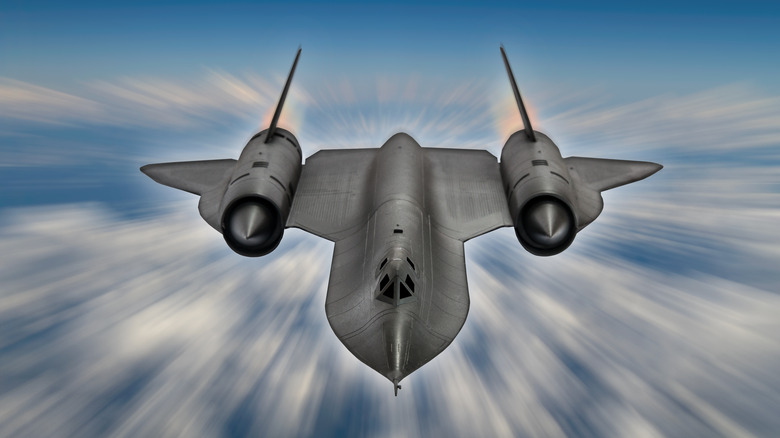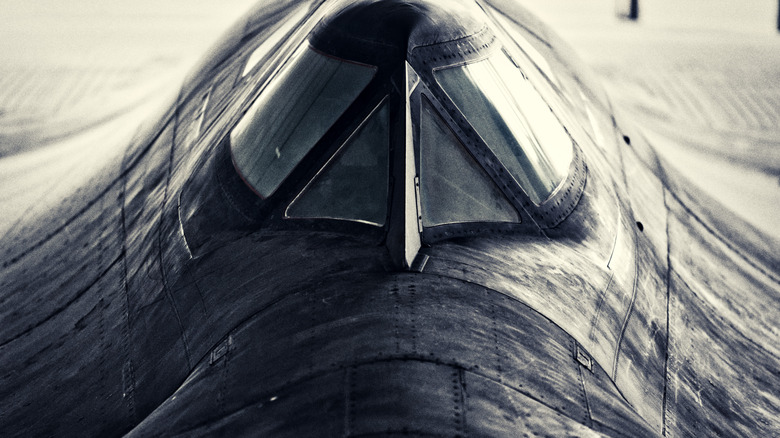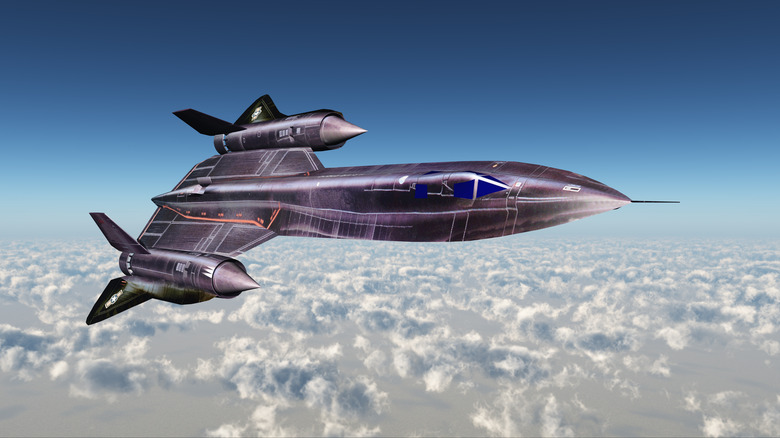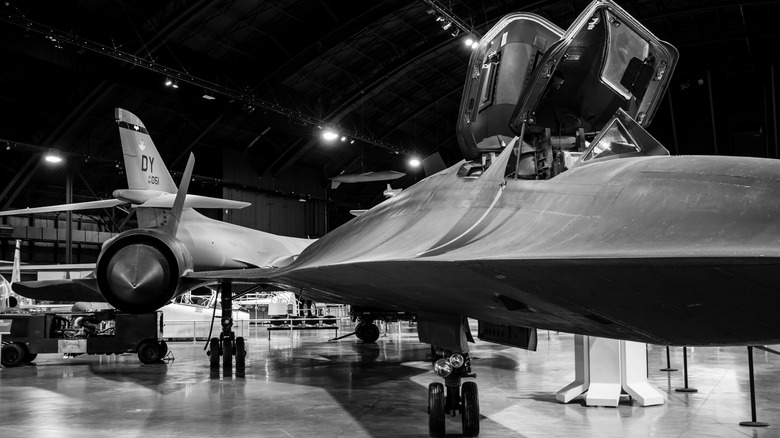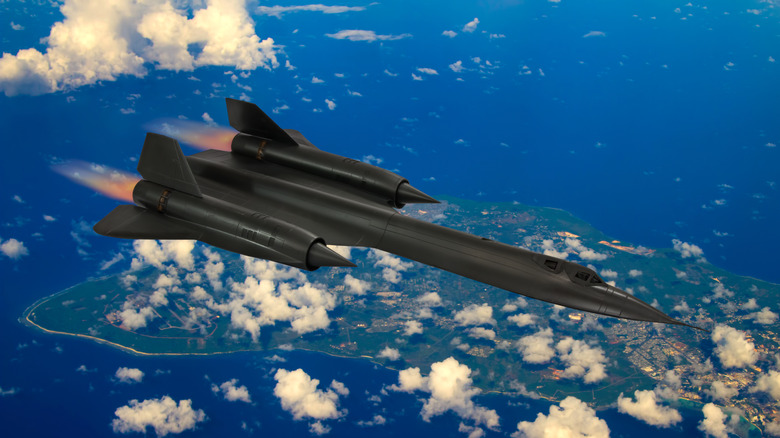The Incredible Features Of The SR-71 Blackbird, The Legendary Supersonic Spy Plane
When thinking of spy planes, many people might immediately jump to UAVs, the famous U-2 incident in 1960, or even modern satellite packages. One iconic aerial surveillance tool that many in the United States will remember is the SR-71 Blackbird.
The aircraft was built in the wake of the U-2 downing's political drama. Concocted by Lockheed's legendary Skunk Works group, it entered service shortly after, making its first flight on December 22, 1964. Quickly, the SR-71 made a name for itself and became the favorite air reconnaissance tool in the arsenal of the U.S. Air Force and CIA. Later, the craft would even be flown by NASA pilots.
Kelly Johnson, one of Lockheed Martin's principal designers raved over the work his team was able to accomplish while working on what would become the SR-71. "Everything had to be invented. Everything," he said of the process. In order to deliver on the mission specs of an "aircraft that can't be shot down," the team worked to enhance every aspect of what a spy plane could be and do.
The product was a 170,000 pound, 107 foot workhorse of an aircraft that pushed the very notion of powered flight to its limits. The pilots and ground crew were immensely specialized, and the tools that the Blackbird brought to the fore were some of the most advanced aerial propulsion, surveillance, and operability creations ever seen.
Titanium skin to support flight operations
The most obvious feature for the casual observer is the exterior carapace. The SR-71 Blackbird was designed with a titanium outer layer. Instead of the typical aluminum that often added lightness and maneuverability to aircraft at the time, the Blackbird required a new approach. The sustained speed target of over 2,000 miles per hour meant that the Blackbird would be in a class of its own. But it also signaled to the design team that an alternative frame would be required.
The forward facing components of the aircraft would routinely be exposed to temperatures at or above 1,000 degrees Fahrenheit. This means that aluminum, which would disintegrate and render the plane useless, couldn't be utilized as normal. Instead, a titanium alloy was built to give the aircraft the required strength against such temperature extremes and structural stability to hold the vehicle together.
One unique complication that made its way into production was the fact that not only did the fuselage have to be assembled, but specialized tools made of the same allow had to be fabricated in order to keep the metal from shattering. In speaking with CNN, aviation historian Peter Merlin noted that "the USSR was, at the time, the greatest supplier of titanium in the world." This meant that sourcing the metal alloy was a monumental task in its own right.
A minimized radar profile to defeat enemy detection
SR-71 Blackbirds predated the use of onboard data relay systems. Therefore, in addition to speed, height, and maneuverability, it was imperative that pilots were able to collect the mission-critical data required and then bring the plane back home unscathed. This is where some of the most innovative technology of the time came into play. Peter Merlin told CNN in an interview that this aircraft "was essentially stealthy before the word stealth was even used."
Without defensive capabilities or weapons systems, the onus of returning with sensitive intelligence fell directly onto the skill of the pilot and the evasive potential of the Blackbird itself. The Blackbird moniker is a nod to the radar-absorbing black paint that was used on these sleek spy planes.
Designers at Lockheed were able to develop some of the first composite materials ever applied to a jet, and combined with the unique fuselage design and specially formulated paint job, the craft was exceedingly difficult to identify with radar technology of the time. This is evidenced in part by the fact that no Blackbird was ever lost to enemy fire or interception.
Even with this impressive camouflage built into the Blackbird, the planes were immensely complicated to maintain and fly, and nearly half (12 of 32) were downed in accidents. Perhaps as a result of this spotty record and ripple effects from the fateful U-2 downing in 1960, no Blackbird ever flew a mission over Soviet airspace.
Life support systems for the fragile, human user
Flying at nearly 100,000 feet above the Earth's surface is no small feat. This places the pilot and co-pilot in a precarious physical position. Above 65,000 feet, aircraft firmly enter into the stratosphere and upon crossing roughly 42,000 feet, passengers must take additional measures to access oxygen and maintain temperature and pressure within the cabin.
The two-person crew must don specialized gear that resembles spacesuits worn by astronauts in order to safely operate the vessel. Specialized oxygen and pressure delivery systems aren't the only life support features within the aircraft, though. While the temperature at this altitude is bone-chilling, the heat produced in flight could cook the passengers (as well as the aircraft itself, requiring the specialized titanium construction).
A heat exchanger was utilized to transfer surface heat from the cockpit area to the fuel tanks to reduce the physical burden on the inhabitants and add heating efficiency to the fuel in advance of its use to propel the jet. The aircraft also required specialized ejection equipment to protect users from both the extreme heat directly around the vessel, and the freezing cold beyond it, as a successfully launched crew descended back down to Earth. The ejection sequence also needed to bring the oxygen supply and suit pressurization equipment along for the ride.
Blistering speed and state of the art reconnaissance equipment
To round out the capabilities of the SR-71 Blackbird, designers had to make it rugged and impossibly fast. The aircraft has been flown over 15,000 miles continuously (with refueling taking place midflight), and the vessel has reached a top speed of 2,193.2 miles per hour (Mach 3.3).
This mind-bending level of speed and flight time makes the Blackbird a virtually unstoppable piece of surveillance equipment. The aircraft can fly higher and faster than anything an adversary might utilize to intercept or shoot down jets. As well, with the range a jet can achieve, conducting long-lasting surveillance operations over mission critical locations is simply a part of the job description.
Even so, the SR-71 was phased out in the 1990s as UAV systems and satellite platforms became more widely available. The SR-71 was never a combat-specific vessel, even with the iconic design that looks a bit like a "Star Wars" Y-Wing. Despite the pop culture prevalence that's seen it give a band their name, and the design featuring in "X-Men" movies, "Transformers: Revenge of the Fallen," and "Armageddon," the plane was eventually destined for redundancy.
During its time in service, however, the SR-71 was outfitted with a wide variety of different remote sensing equipment. The platform was used to take images of ground events, collect radar data, and other technical information that simply couldn't be gleaned any other way.
The Optical Bar Camera that was a standard installation in the aircraft could film 100,000 square miles per hour. The unit initially used a 24-inch focal length and could capture high resolution imagery 72 miles across, running from one horizon to its opposite.
